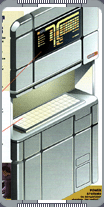
Replicator
Replicators are an essential part of several starship systems, including holodecks and food terminals.
 Replicators are devices equipped with a built-in, low-resolution transporter engine. They are used to
transform raw matter into a specified inanimate object and are typically used to fabricate food or equipment.
Almost everything can be replicated, provided a molecular template of the item is stored in the replicator's
memory, though some materials, such as deuterium, are too complex to be replicated. The introduction of
replicator technology during the first half of the 24th century changed space travel forever.
Replicators are devices equipped with a built-in, low-resolution transporter engine. They are used to
transform raw matter into a specified inanimate object and are typically used to fabricate food or equipment.
Almost everything can be replicated, provided a molecular template of the item is stored in the replicator's
memory, though some materials, such as deuterium, are too complex to be replicated. The introduction of
replicator technology during the first half of the 24th century changed space travel forever.
Replicator technology is an essential element of Starfleet holodecks. Although most materials can be
simulated by the use of forcefields, some (including substances such as snow) are actually created by
replicators and can be removed from the holodeck. Replicators are also used to fabricate food supplies and
spare parts. On a Galaxy-class starship such as the
USS Enterprise NCC-1701-D, the replicator system headends are
found on deck 12 in the saucer module and in main engineering on deck 34. Access to the replicator system is
via a replicator terminal. All crew members' quarters are fitted with personal replicator terminals.
Terminals are also found on the bridge, Ten-Forward, the captain's ready room, and in public gathering
places.
In addition to the main terminals, specialized terminals can be found in several venues, including medical
replicators in sickbay which can generate rare medications and medical supplies. Replicators give physicians
the freedom to respond with precisely the correct treatment, instead of making do with the limited number of
supplies which would otherwise be carried. The hardware replicator in main engineering creates parts and
tools. The ship also carries an in-depth inventory of spare parts since the replicators may go offline
during emergencies. In the waste management department, the largely automated recycling system uses
replicators to transform dangerous toxic waste into safe, inert objects, and to transmute cleansed waste
products into raw matter which is recycled back into the system.
Replicators are routinely used to supply the crew with food and drinks. The process of getting a meal from a
replicator is very straightforward. The hungry crew member stands before a replicator terminal and gives his
meal order, either verbally or by using the terminal's user-control pad.
As soon as the meal order is issued, the food replicator system goes into action. The order is quickly
matched to one or more of the 4,500 food item templates stored in the replicator database. Once the specific
templates have been accessed, the food replicator dematerializes an appropriate volume of special raw matter
stocked for this purpose. This matter is then rearranged by a quantum geometry transformational matrix field
until it matches the molecular pattern template. It is then routed through a series of waveguide conduits
back to the order-issuing terminal, where it materializes in the replicator terminal's phase transition
chamber. The complete cycle - from placing order to receiving the meal - takes no more than a few seconds.
 Food replicator raw material is carefully engineered organic particulate suspension matter, with a structure
that closely matches replicated food. This guarantees that the time and enegry required to reorganize the
raw material is a fraction of that needed when starting from alien base material. Supplies of this raw food
stock are taken onboard during standard resupply stops at a starbase. If this is not practical, the system
can reclaim 82 percent of foodwaste by osmotic and electrolytic fractioning. Although replicated food looks
and tastes like the real thing, the templates only contain digital image data created at the molecular level.
Living beings cannot be replicated because the data requirements for quantum electronstate and Brownian
motion information are prohibitive, and would require a billionfold increase in the amount of memory
dedicated to the replicator systems. In contrast, transporters, which operate in realtime, use quantum-level
measurements that can safely process live beings.
Food replicator raw material is carefully engineered organic particulate suspension matter, with a structure
that closely matches replicated food. This guarantees that the time and enegry required to reorganize the
raw material is a fraction of that needed when starting from alien base material. Supplies of this raw food
stock are taken onboard during standard resupply stops at a starbase. If this is not practical, the system
can reclaim 82 percent of foodwaste by osmotic and electrolytic fractioning. Although replicated food looks
and tastes like the real thing, the templates only contain digital image data created at the molecular level.
Living beings cannot be replicated because the data requirements for quantum electronstate and Brownian
motion information are prohibitive, and would require a billionfold increase in the amount of memory
dedicated to the replicator systems. In contrast, transporters, which operate in realtime, use quantum-level
measurements that can safely process live beings.
The replicator templates use compression techniques, repeating instructions, and averaging to further reduce
the size of the template and to conserve storage space on the computer. Consequently, replicated foods often
contain a number of single-bit erros. Although the taste and nutritional content of the food is essentially
unaffected, this is why some find their favorite dishes 'not quite right' when replicated.
|
|
"HOLOTECHNOLOGY - REPLICATORS" - NOVEMBER 1999 ISSUE 7 STAR TREK: THE MAGAZINE COPYRIGHT OF PARAMOUNT PICTURES.
|